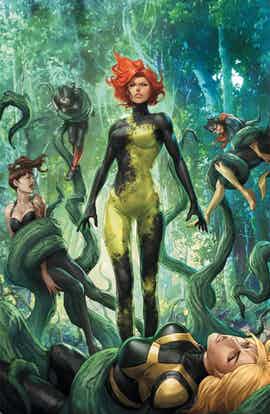
In “Birds of Prey” #11, writer Duane Swierczynski kicks up the storytelling pace, but sacrifices his usual narrative subtlety, taking most of the charming originality of the team and throws it out the window. What’s left is a prefab offering readers have seen a million times before, even if the wallpaper details are new.
The cover hints at the crux of the issue — Poison Ivy turns against her teammates. Inevitably, it’s part of the whole villain-becomes-a-hero rehab and relapse package. I could wish this twist had come later, but I’d rather it was less blandly executed. Any comic reader knows Ivy would choose the environment over her teammates — Ivy would choose the environment over diamonds, ice cream and her mom. Since Ivy can make her “Earth always wins” choice anytime, it would be much more interesting if Swierczynski didn’t force her hand with an extremely contrived ticking-time-bomb scenario.
In previous issues, I enjoyed seeing Starling mock Poison Ivy, or watching Batgirl get in her face, but it also made me feel for the villainess. It made her seem vulnerable, even lonely. Now, those juicy team dynamics and Ivy’s awkward odd-duck status are lost. Poison Ivy’s return to villaindom is a caricature of her most cardboard-like moments, complete with trite Earth-first dialogue. She even takes the stage for an explanatory, info-dump monologue. Furthermore, the cliffhanger ending is almost sure to be a fake-out with a gunshot blast off-screen.
On top of these narrative disappointments, “Birds of Prey” #11 is a visual mess. Artists Travel Foreman and Timothy Green II share penciling duties with Jeff Huet and Joseph Silver on inks. I was looking forward to more of Foreman’s work, but we see only a few pages with his delicate spidery line and well-balanced panel and page compositions. Green’s pencils are far less ambitious and skillful, and worse, his style doesn’t look anything like Foreman’s, creating a jarring transition between the two styles.
For the duration of the New 52’s “Birds of Prey,” Ivy has had eyes with alien-looking black sclera and green irises, despite several changes in the art team. In “Birds of Prey” #11, Ivy’s black sclera turn white ten pages in for no reason, then go back to black near the end of the issue, again for no reason (other than the penciller switch). It’s a screw-up, and this kind of lack of attention to detail and visual continuity is true of the entire issue. Background detail is sparse or totally absent to the point that the characters don’t seem grounded in space for half the issue. In the Green-penciled pages, all the women look almost exactly alike. There is only one set chin/eyes/eyebrows/mouth/body repeated across the page, like cookies from the same cookie-cutter, distinguished only by hair and costume icing.
This issue might turn out to be an unfortunate blip. A new series artist is slated to come on board soon and Swierczynski could still take the story to a lot of interesting places. Still, this issue soured me some on the book. Many of the qualities that made “Birds of Prey” different from the rest of the DC lineup — Swierczynski’s slow, moody pacing and subtle character development, skillful art by Foreman or Saiz – are disappointingly absent in this issue.

